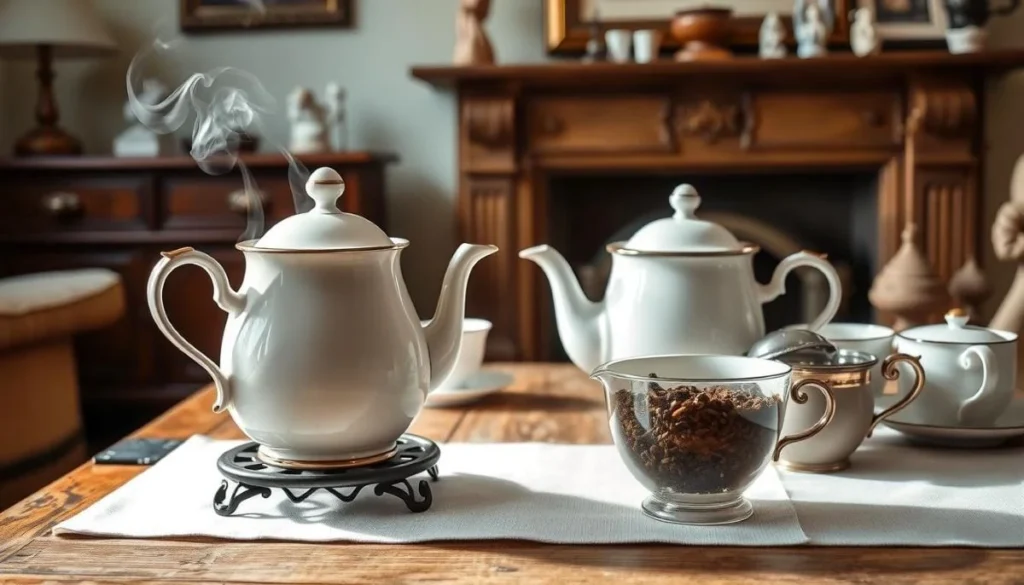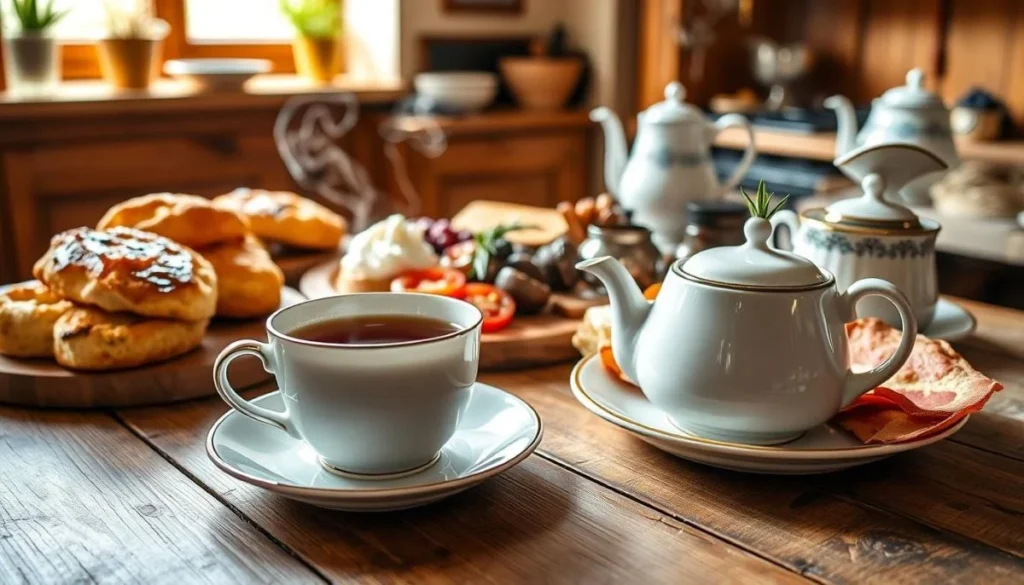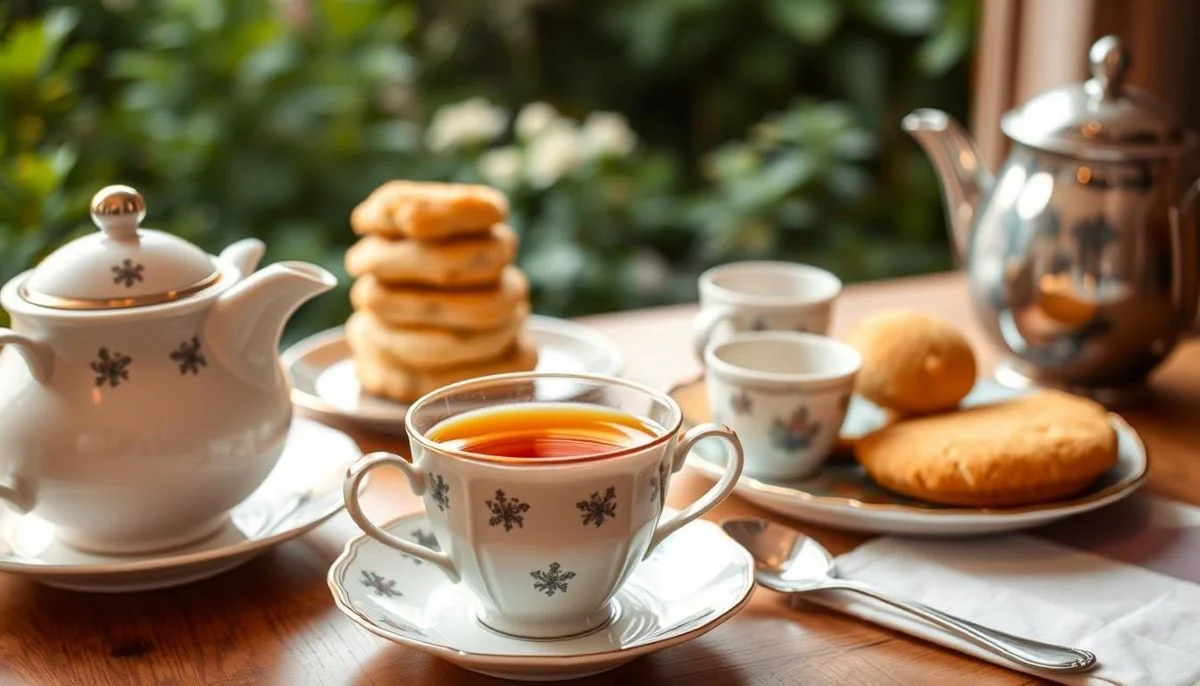Discover the Delights of English Breakfast Tea
Every morning, millions of tea lovers grab a steaming cup of English Breakfast tea. This rich, robust beverage is at the heart of British tea culture. It’s more than a drink; it’s a morning ritual that connects people worldwide.
When you try English Breakfast tea, you’ll see why it’s loved by so many. Its bold, malty flavor wakes up your senses, making it the perfect morning start. Unlike other teas, it holds its own against milk and sugar.
Imagine a tea that tells a story with every sip. English Breakfast tea is a tale of tradition, craftsmanship, and cultural heritage. It’s not just a drink; it’s a global connection, uniting people through a shared love of a well-brewed cup.
Whether you’re a seasoned tea drinker or new to tea, English Breakfast tea has something special to offer. Its complex blend of black teas provides a taste experience that’s both comforting and invigorating.
Get ready to explore the world of English Breakfast tea. It’s a journey where flavor, history, and tradition come together in one amazing cup.
What is English Breakfast Tea
English breakfast tea is a beloved black tea blend loved by many. It’s more than a morning drink; it’s a cultural symbol. It connects old traditions with today’s love for tea.
English breakfast tea is made from black tea leaves from various places. These leaves come from different tea-growing areas. This mix creates a rich and enjoyable taste.
Origins of the Blend
The history of English breakfast tea began in the 1840s. Back then, tea culture was growing fast in Great Britain. Tea makers wanted to make a strong tea for a big morning meal. And so, this famous black tea was born.
Traditional Blend Components
- Assam tea from India
- Ceylon tea from Sri Lanka
- Kenyan black tea
- Chinese black tea varieties
Distinctive Characteristics
English breakfast tea is known for its bold taste. The mix of teas gives it a rich, malty flavor. It’s great with milk and sugar.
| Characteristic | Description |
|---|---|
| Caffeine Content | 30-60 mg per serving |
| Brewing Temperature | 90°C (194°F) |
| Steeping Time | 2-3 minutes |
Drinking English breakfast tea is like enjoying a global favorite. Its strong taste and versatility make it a favorite in tea collections everywhere.
The Rich History of English Breakfast Tea
The story of English Breakfast tea is fascinating. It began in the 17th and 18th centuries. This time was full of global trade and cultural exchange.
Tea traders from England looked for the perfect morning tea. They picked tea leaves from different places. This created unique blends that became famous in British tea culture.
“The perfect cup of tea tells a story of tradition, craftsmanship, and global connection.”
Important moments in English Breakfast tea’s history include:
- First mentioned by an American tea company in 1843
- Popularized by Scottish tea seller Robert Drysdale by 1892
- Became a staple during the expansion of British colonization
The traditional blend includes:
| Tea Origin | Characteristic |
|---|---|
| Chinese Keemun | Smooth base flavor |
| Ceylon | Bright, crisp notes |
| Assam | Strong, malty undertones |
Queen Victoria helped make this tea popular in the 19th century. She turned it into a cultural icon. Its strong flavor and energizing qualities were perfect for English breakfasts.
Today, English Breakfast tea is loved all over the world. It connects people through its rich history and unique taste.
Essential Brewing Techniques for the Perfect Cup
Brewing the perfect cup of English Breakfast tea is an art. It combines precision and passion. Knowing the right tea brewing methods can make your loose leaf tea experience amazing.

Mastering the right brewing techniques is key. It ensures you get the fullest flavor from your tea leaves. For black tea like English Breakfast, getting the details right is crucial.
Water Temperature Guidelines
Temperature is important in tea preparation. For English Breakfast tea, the ideal water temperature is 200°F to 212°F. Boiling water brings out the robust flavors of black tea.
- Boil fresh, filtered water
- Allow water to reach full boiling point
- Let water cool slightly before pouring over tea leaves
Steeping Time Recommendations
Timing is everything when brewing loose leaf tea. For English Breakfast, the sweet spot is 4 to 5 minutes. Steeping too short misses the rich flavors. Steeping too long makes it bitter.
- Use a timer for precision
- Adjust steeping time to personal taste preference
- Remove tea leaves immediately after steeping
Tea-to-Water Ratio
The right balance of tea leaves to water is key. For loose leaf English Breakfast tea, use 1 teaspoon of tea per 8 ounces of water.
Pro tip: Experiment with ratios to find your perfect cup!
Health Benefits and Nutritional Value
English Breakfast tea is more than a morning pick-me-up. It’s a black tea rich in antioxidants that boost your health. These antioxidants help in many ways.
Its health perks go beyond its great taste. Studies show black tea can improve heart health. A 2020 review found:
- 4% lower risk of death from heart disease
- 2% lower risk of heart attack
- 4% lower risk of stroke
- 1.5% lower risk of death from all causes
English Breakfast tea is also full of minerals like potassium and manganese. These help your body work right and keep bones strong.
| Nutrient | Health Benefit |
|---|---|
| Potassium | Boosts energy, improves hydration, may lower blood pressure |
| Manganese | Supports bone health, regulates metabolism |
| Polyphenols | Reduces cholesterol, helps control blood sugar |
English Breakfast tea has just the right amount of caffeine. An 8-ounce cup has 40 to 70 milligrams. The NHS says drinking 3-4 cups a day is best.
Adding English Breakfast tea to your day is good for your health. It’s a tasty way to care for your body.
Comparing Loose Leaf vs. Bagged English Breakfast Tea
Choosing between loose leaf tea and bagged tea can change how you enjoy tea. Each option has its own benefits and challenges for those looking for the best English Breakfast tea.
Quality Differences
Loose leaf tea is known for its high quality. It uses whole leaves, unlike tea bags that have “tea dust.” This means loose leaf tea has a richer taste and more complex flavors.
- Loose leaf tea allows multiple steeps (2-3 times)
- Higher antioxidant levels in loose leaf tea
- More expansive leaf development during brewing
Flavor Profiles
The way you brew your tea greatly affects its taste. Loose leaf tea offers a more detailed and true flavor. Tea bags can limit leaf expansion, resulting in a less robust brew. Whole leaves can release all their flavors when they have enough space to steep.
Cost Considerations
Even though tea bags are more convenient, loose leaf tea can be cheaper over time. A 250g bag of loose leaf tea costs £24.50 and can make 80-125 cups. This is more than a box of tea bags, which lasts about 20 days.
| Tea Type | Cost | Cups per Purchase |
|---|---|---|
| Loose Leaf Tea | £24.50 | 80-125 cups |
| Bagged Tea | £22 (4 boxes) | 80 cups |
Your choice of tea depends on what you like, how much time you have, and how serious you are about brewing. Both loose leaf and bagged teas have their own special place in a tea lover’s collection.
Pairing English Breakfast Tea with Food
Exploring British tea culture with English Breakfast tea is a culinary adventure. This robust black tea blend pairs well with many dishes. It makes your meals special.

Black tea’s full-bodied flavor is great with hearty breakfast items. It goes well with classic morning foods:
- Crispy bacon and scrambled eggs
- Buttered toast with jam
- Flaky pastries and scones
- Savory breakfast sandwiches
The rich taste of flavored breakfast teas is not just for breakfast. Try these food pairings for a better tea experience:
- Creamy chocolate desserts
- Grilled meats with robust spices
- Aged cheeses
- Nutty pastries
“A perfect cup of tea can transform an ordinary meal into an extraordinary culinary journey.” – Tea Enthusiast
When making your English Breakfast tea, adding milk can soften its strong taste. This makes the flavor more balanced. Try different pairings to find your favorite.
Understanding Tea Grades and Quality Markers
Exploring black tea varieties means learning about tea grades. This system shows the quality of tea, helping you pick the best brew.
Tea origins greatly affect its quality and taste. The grading process looks at the size, appearance, and processing of tea leaves.
Tea Leaf Classifications
The tea leaf grading system uses special acronyms. Here are the main ones to know:
- SFTGFOP: Super Fine Tippy Golden Flowery Orange Pekoe – The highest grade
- FTGFOP: Fine Tippy Golden Flowery Orange Pekoe – High-quality whole leaf
- TGFOP: Tippy Golden Flowery Orange Pekoe – Good quality whole leaf
- BOP: Broken Orange Pekoe – Smaller leaf pieces
- BOPF: Broken Orange Pekoe Fannings – Typical tea bag grade
Regional Variations
Tea-producing regions have their own grading ways. China, Sri Lanka, and India each add unique flavors to English Breakfast tea blends.
| Region | Characteristic | Typical Grade |
|---|---|---|
| China | Delicate Flavor | FTGFOP |
| Sri Lanka | Bold Taste | TGFOP |
| India | Strong Body | GFOP |
Quality Indicators
When picking tea, look for these quality signs:
- Bright, consistent leaf color
- Presence of golden tips
- Uniform leaf size and shape
- Clean, fresh aroma
- Minimal dust or broken pieces
Higher-grade teas often have more complex flavors. They offer a better drinking experience. Your taste buds will appreciate the choice!
Storage Tips and Shelf Life
Keeping your loose leaf tea fresh is all about the right storage. The right storage can make your tea taste better for longer.
Tea can spoil if exposed to:
- Sunlight
- Moisture
- Temperature changes
Choose the right container to keep your tea fresh. Look for:
- Opaque ceramic containers
- Dark-colored glass jars
- Metal tins with tight lids
“The secret to perfect tea is in its preservation” – Tea Masters
Tea types have different shelf lives. Black tea stays good for two years. White tea is best within a year. Green tea should be drunk within 18 months.
Tip for tea lovers: Store tea in a cool, dark spot. Keep it away from strong smells. Don’t put most teas in the fridge, but Japanese green teas do well there.
Check your tea’s freshness before you brew it. Bad signs include no smell, dull color, and weak taste. If stored right, your tea will taste amazing and keep its true flavor.
Reach more breakfast tea ideas by visiting links bellow:
- Start Your Day Right with English Breakfast Tea
- Discover Premium English Breakfast Loose Leaf Tea Today
- Is English Breakfast Tea Black Tea? Explore the Facts
- English Breakfast Tea Caffeine Content Guide
Conclusion
English breakfast tea is more than just a drink. It’s a way to connect with a rich global tea tradition. This strong black tea blend is a key part of British tea culture. It gives you a bold and refreshing start to your day.
The story of English breakfast tea is fascinating. It’s made from black tea leaves from Assam, Ceylon, and Keemun. It has about 40-70 milligrams of caffeine per cup. This gives you a gentle energy boost and may help with your health.
Whether you love tea or are just starting, English breakfast tea is worth trying. You can enjoy it with milk, sugar, or on its own. Its history in British culinary traditions inspires tea lovers everywhere. It invites you to join a timeless ritual of enjoyment and wellness.
When you make your next cup, think of English breakfast tea as more than a drink. It connects you to a global heritage and offers a moment of reflection. Each sip is a chance to explore flavor and culture. Enjoy the journey and let each sip tell its own story.

